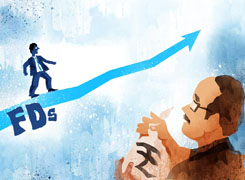Ramalingam Kalirajan |10870 Answers |Ask -Follow
Mutual Funds, Financial Planning Expert - Answered on May 18, 2024
He has an MBA in finance from the University of Madras and is a certified financial planner.
He is the director and chief financial planner at Holistic Investment, a Chennai-based firm that offers financial planning and wealth management advice.... more

I’m at 39 and I don’t have any liability now . I have a FD of 30 lacs . I wish to invest this fund for a retirement income from 50 years for me . 1. Is it good to continue the FD ? 2. Any good retirement plans / investment options which can give a decent monthly income / pension Kindly suggest .
That's fantastic planning for your retirement at 50! Let's explore ways to potentially maximize your retirement income, going beyond just FDs.
FDs for Retirement:
Safety and Guaranteed Returns: FDs offer guaranteed returns and are a safe option. But, interest rates may not always outpace inflation, reducing purchasing power in the long run.
Retirement Planning Options:
Equity Mutual Funds (MFs): These offer the potential for higher growth compared to FDs, but also involve market risks. Actively managed equity MFs involve experienced fund managers who try to pick stocks to outperform the market. Actively managed funds come with higher fees compared to passively managed funds.
Debt MFs: Provide stability and regular income, which can be helpful for supplementing your pension.
Building a Balanced Portfolio with SWPs:
Mix of Equity and Debt: A well-diversified portfolio with equity and debt MFs helps manage risk and provides growth potential with some income generation.
Systematic Withdrawal Plan (SWP): Once you near retirement, consider an SWP from your equity MFs. SWP allows you to withdraw a fixed amount regularly, using the fund's corpus and any capital appreciation. This can generate a steady income stream throughout your retirement.
Increase Debt Allocation Over Time: As you approach retirement, gradually shift your portfolio towards debt MFs to preserve your corpus and generate regular income.
SIP (Systematic Investment Plan): Invest regularly in MFs through SIPs to benefit from rupee-cost averaging and potentially ride out market volatility.
Maximizing Your Retirement Income:
Employee Provident Fund (EPF): If you are salaried, utilize your EPF for retirement benefits.
National Pension System (NPS): Consider NPS, a government-backed pension scheme, for tax benefits and potential long-term growth.
Review and Rebalance: Regularly review your portfolio (at least annually) and rebalance as needed to maintain your target asset allocation.
Seeking Professional Guidance:
Personalized Plan: A Certified Financial Planner (CFP) can create a personalized retirement plan considering your risk tolerance, investment horizon, and desired retirement income. They can recommend a suitable asset allocation, suggest specific actively managed funds based on your needs, and guide you on implementing a strategic SWP strategy.
Remember:
Discipline is key to reaching your retirement goals.
Start investing early to benefit from compounding.
By combining these strategies and seeking professional advice, you can work towards a secure and comfortable retirement with a steady income stream!
Best Regards,
K. Ramalingam, MBA, CFP,
Chief Financial Planner,
www.holisticinvestment.in
You may like to see similar questions and answers below
Ramalingam Kalirajan |10870 Answers |Ask -Follow
Mutual Funds, Financial Planning Expert - Answered on Jun 25, 2024
Ramalingam Kalirajan |10870 Answers |Ask -Follow
Mutual Funds, Financial Planning Expert - Answered on Jun 03, 2024
Ramalingam Kalirajan |10870 Answers |Ask -Follow
Mutual Funds, Financial Planning Expert - Answered on Aug 14, 2024
Ramalingam Kalirajan |10870 Answers |Ask -Follow
Mutual Funds, Financial Planning Expert - Answered on Oct 11, 2024
Ramalingam Kalirajan |10870 Answers |Ask -Follow
Mutual Funds, Financial Planning Expert - Answered on May 14, 2025
Dr Dipankar Dutta |1837 Answers |Ask -Follow
Tech Careers and Skill Development Expert - Answered on Dec 05, 2025
Dr Shyam Jamalabad |108 Answers |Ask -Follow
Dentist - Answered on Dec 05, 2025
Dr Shyam Jamalabad |108 Answers |Ask -Follow
Dentist - Answered on Dec 05, 2025
Dr Shyam Jamalabad |108 Answers |Ask -Follow
Dentist - Answered on Dec 05, 2025
Dr Dipankar Dutta |1837 Answers |Ask -Follow
Tech Careers and Skill Development Expert - Answered on Dec 05, 2025
Ulhas Joshi |280 Answers |Ask -Follow
Mutual Fund Expert - Answered on Dec 05, 2025
Dr Dipankar Dutta |1837 Answers |Ask -Follow
Tech Careers and Skill Development Expert - Answered on Dec 04, 2025
Ravi Mittal |676 Answers |Ask -Follow
Dating, Relationships Expert - Answered on Dec 04, 2025
Anu Krishna |1745 Answers |Ask -Follow
Relationships Expert, Mind Coach - Answered on Dec 04, 2025
Anu Krishna |1745 Answers |Ask -Follow
Relationships Expert, Mind Coach - Answered on Dec 04, 2025



























